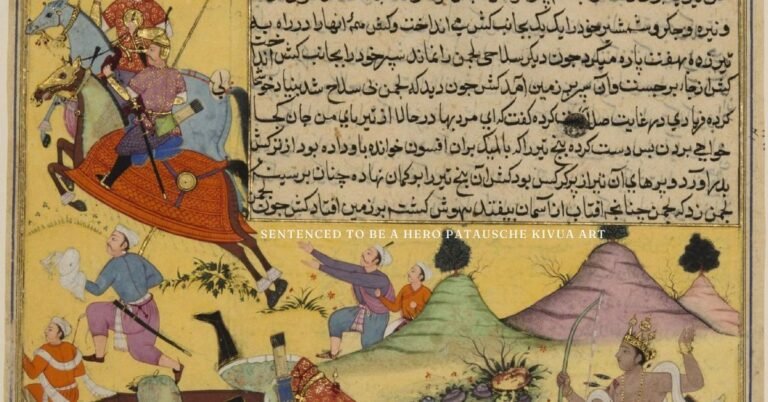In the expansive world of storytelling, the narrative of being “sentenced to be a hero” offers a compelling lens through which the concepts of duty, sacrifice, and creativity are explored. One such narrative that has caught the attention of art enthusiasts and literature lovers alike is “Sentenced to Be a Hero Patausche Kivua Art.” This unique blend of heroism and artistic expression bridges the gap between traditional hero tales and avant-garde creativity, making it a fascinating subject of discussion. In this article, we delve into its origins, significance, and the artistic techniques that set it apart.
The Origins of “Sentenced to Be a Hero”
At its core, “Sentenced to Be a Hero” explores the idea of involuntary heroism. Unlike conventional tales where protagonists willingly take up the mantle of heroism, this narrative centers on characters thrust into heroic roles by external circumstances or cosmic decree. The concept’s roots can be traced to ancient myths and modern interpretations, such as manga, anime, and contemporary art movements.
The term “Patausche Kivua” adds an intriguing dimension to the narrative. Derived from a blend of cultural inspirations, the phrase hints at the fusion of indigenous motifs with contemporary storytelling. Kivua, in particular, resonates with African linguistic traditions, suggesting themes of community, destiny, and resilience. When paired with the idea of “being sentenced,” it crafts a nuanced portrayal of reluctant heroes navigating their roles in unpredictable worlds.
Artistic Representation in Patausche Kivua Art
“Patausche Kivua Art” emerges as an artistic interpretation of the hero’s journey. Artists working within this framework use a variety of mediums to portray the struggles and triumphs of reluctant heroes. Here are some notable artistic elements:
1. Symbolism and Visual Metaphors
Symbolism plays a significant role in Patausche Kivua Art. For example:
- Chains and Bindings: Represent the constraints of destiny and the burdens of heroism.
- Ascending Figures: Depict the growth and eventual acceptance of one’s role.
- Broken Masks: Symbolize the shedding of societal expectations to embrace authenticity.
2. Techniques and Styles
Artists employ diverse techniques to create compelling visual narratives:
- Mixed Media: Combining traditional painting with digital art to create textured, layered works.
- Monochromatic Palettes: Utilizing black-and-white or muted tones to emphasize emotional depth.
- Abstract Forms: Representing internal conflicts through distorted, surreal imagery.
3. Cultural Fusion
One of the defining features of Patausche Kivua Art is its cultural hybridity. By integrating motifs from African, Asian, and European traditions, it creates a universal yet deeply personal visual language.
Key Themes Explored in “Sentenced to Be a Hero Patausche Kivua Art”
1. The Burden of Destiny
A recurring theme is the weight of destiny and how it shapes the hero’s journey. Characters are often portrayed in moments of hesitation or resistance, emphasizing the human struggle against predetermined roles.
2. The Transformation Journey
Central to this narrative is the transformation from reluctance to acceptance. This metamorphosis is often illustrated through progressive imagery, where a character’s physical and emotional states evolve over time.
3. Community and Interconnectedness
Unlike individualistic hero narratives, “Patausche Kivua Art” highlights the role of community in shaping the hero’s path. Many pieces depict interconnected figures, signifying the collective effort required to support a reluctant hero.
Why “Sentenced to Be a Hero Patausche Kivua Art” Matters Today
In a world grappling with societal and personal challenges, the concept of reluctant heroism resonates deeply. Here’s why:
1. Reflection of Modern Struggles
The idea of being “sentenced” to heroism mirrors the pressures many individuals face in contemporary society, from family expectations to societal demands.
2. Celebration of Imperfection
Unlike traditional hero narratives that often glorify perfection, this narrative embraces flaws, vulnerabilities, and internal conflicts, making it more relatable.
3. Encouragement of Creative Expression
Patausche Kivua Art inspires both artists and audiences to explore unconventional storytelling methods. By breaking away from rigid norms, it encourages innovation and individuality.
Practical Applications: How to Incorporate Patausche Kivua Art in Daily Life
1. Home Décor
Invest in Patausche Kivua-inspired artwork to create a thought-provoking and inspiring environment. Look for prints or originals that depict themes of transformation and resilience.
2. Journaling and Reflection
Use the narrative of “Sentenced to Be a Hero” as a framework for personal growth. Reflect on moments when you’ve felt “sentenced” to certain roles and how you’ve navigated them.
3. Creative Projects
Whether you’re an artist, writer, or filmmaker, draw inspiration from this narrative to craft stories that challenge conventional norms and celebrate the complexity of human experience.
Comparison Chart: Traditional Heroism vs. Sentenced Heroism
| Aspect | Traditional Heroism | Sentenced Heroism |
|---|---|---|
| Initiation | Voluntary acceptance of the role | Forced into the role by external circumstances |
| Character Traits | Courageous, confident, skilled | Reluctant, flawed, evolving |
| Focus | Individual achievements | Collective growth and interconnectedness |
| Resolution | Clear victory over adversaries | Ambiguous, often ongoing struggles |
| Artistic Representation | Realistic, idealized depictions | Abstract, emotionally charged portrayals |
Conclusion
“Sentenced to Be a Hero Patausche Kivua Art” is more than just a narrative or artistic style; it is a testament to the resilience of the human spirit. By embracing imperfection and highlighting the transformative power of struggle, it offers a refreshing perspective on heroism. Whether through thought-provoking art or relatable storytelling, this concept continues to inspire and captivate audiences worldwide. If you’re looking to explore themes of duty, creativity, and interconnectedness, this unique narrative provides endless avenues for discovery and expression.
FAQs
1. What is the central idea of “Sentenced to Be a Hero Patausche Kivua Art”?
The central idea revolves around the concept of reluctant heroism, where individuals are thrust into heroic roles against their will. It emphasizes themes of struggle, transformation, and community.
2. How does Patausche Kivua Art differ from traditional hero art?
Patausche Kivua Art employs abstract and symbolic techniques to portray the internal and external conflicts of reluctant heroes. It often features cultural fusion and emphasizes collective effort over individual achievement.
3. Can I purchase Patausche Kivua-inspired artwork?
Yes, many contemporary artists create pieces inspired by this narrative. Look for galleries or online platforms specializing in mixed media and culturally inspired art.
4. How can I use the “Sentenced to Be a Hero” theme in personal projects?
You can draw inspiration from this theme for writing, painting, or other creative endeavors. Focus on exploring human vulnerability, resilience, and the interplay between personal and societal expectations.
5. Why is this narrative relevant today?
The narrative resonates with modern audiences because it reflects the complexities of contemporary life, where individuals often face pressures to fulfill roles imposed by external forces.

